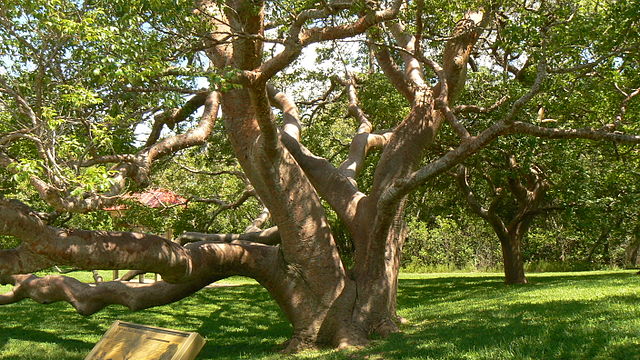
For those with an interest in history, the downtown Tampa area has many places worthy of your time. While the common joke in Florida is that anything built before 1980 is considered historic, the area actually has a rich and colorful history involving explorers, Native Americans, pirates and railroad tycoons.
A look at Historical Downtown Tampa
A good place to start, believe it or not, is a tree.
Located on the campus of the University of Tampa, which sits along the Hillsborough River in downtown Tampa, the De Soto Oak is one of the oldest historical sites in the country. Many believe that it was here that explorer Hernando De Soto, who had made his landing at Terra Ceia island in Manatee County in 1539, first met with the local Native American tribes, most likely the Tocabaga.
De Soto made his way to Tampa Bay after his landing to the south. It was under the beautiful oak tree that De Soto met with the local tribe leaders.
But that’s just the start of interesting historical places to visit in downtown Tampa. Here are some others.
University of Tampa Plant Museum. This is a must see for those visiting Tampa, and if you are at the De Soto Oak, you are only a few steps away. The museum was originally the Tampa Bay Hotel, built in 1891. The beautiful building – and its minarets – remain the signature image of Tampa to this day.
Henry B. Plant, a railroad magnate, paid to construct the hotel after a railroad line was built connecting Tampa to the railroad running down the east coast of Florida. Moorish architecture combined with opulent furniture and a location in a tropical climate made the hotel a top destination spot for the rich and powerful for decades. Among the visitors were Teddy Roosevelt, Babe Ruth and Sarah Bernhardt. There are tours of the museum and every December a Victorian Christmas Stroll in which large sections of the museum are decorated in Victorian era holiday accessories.
The Tampa Theatre. Listed on the National Registry of Historic Places, the beautiful Tampa Theatre is not only a great place to visit for a tour, but also continues to be a working theater where you can catch a movie. Designed by architect John Eberson, the theater was built in 1926 to resemble a Mediterranean courtyard complete with a ceiling designed to look like a clear, starry night. No words can capture the beauty of the theater, which is another must-see for those in Tampa with an interesting in history. The theater also hosts many private parties and concerts.
Tampa Bay History Center. Across the Hillsborough River on the south side of downtown, the Tampa Bay History Center is located along the downtown Riverwalk. The Riverwalk offers a beautiful way to stroll along the Hillsborough River and the Garrison Channel. Outside the Tampa Bay History Center, in Cotanchobee Fort Brooke Park, a series of plaques tell the history of Native Americans in Tampa Bay as well as the establishment of the first settlement there, Fort Brooke. The fort was built in 1824 under President James Monroe and was the first step to eventually attracting settlers who established the city of Tampa in the 1830s.
The history center itself provides a comprehensive look at Tampa’s past, how it evolved from a minor outpost to become one of the nation’s largest cities. Both the plaques and the museum offer information on the Seminole Wars, which occurred in three phases between about 1817 and 1858. Many Seminoles were forced to reservations in the west. Those that escaped into the South Florida swamps never surrendered.
American Victory Ship. Docked near the Florida Aquarium, this is one of only four fully-functional World War II ships in the country. Both guided and self-tours are available, and the ship also is used for special events such as the Fourth of July celebration. American Victory is listed on the National Register of Historical Places.
Oaklawn Cemetery. Here’s one you won’t find on a lot of guide maps, but it’s a fascinating place for history buffs. Located north of downtown in a quiet area at the intersection of Morgan and Harrison streets, Oaklawn is Tampa’s first burial ground. Among those buried there are Vincente Martinez Ybor, the cigar manufacturer who founded Ybor City, which is now part of Tampa and a historic district in its own right.
Other notable graves include Tampa’s first mayor, Joseph B. Lancaster, and Charlie Wall, a businessman and reputed organized crime figure who was killed in his own home in one of Tampa’s most famous murder cases.
But the most famous grave, justifiably, is that for William Ashley and Nancy Ashley. Erected in 1873, the marker, entitled “master and servant,” says that William, a white man, and Nancy, his African American slave, wished to be buried together because “in death they are not separated; Stranger consider and be wiser, In the grave all human distinction, of race or caste, mingle together in one common dust.”
Researchers now know that the two had been lovers for years, and that William, concerned what might happen to Nancy when he died, left instructions for Nancy to be cared for after his death and buried with him when she died. His friend and executor, John Jackson, despite likely knowing what he might face in the post-Civil War south, not only carried out his friend’s wishes but even signed the monument himself. It’s one of Tampa’s most memorable stories.

